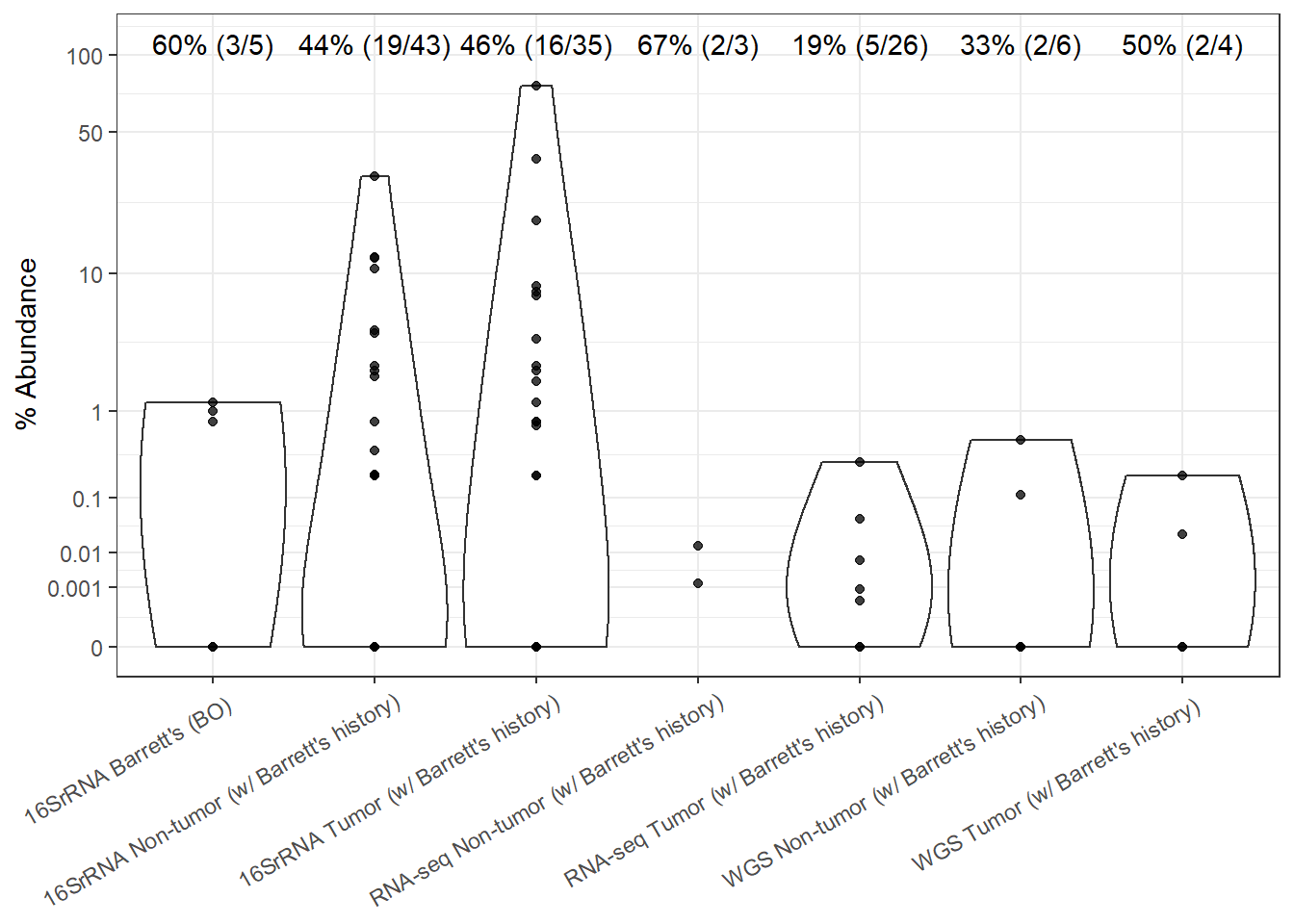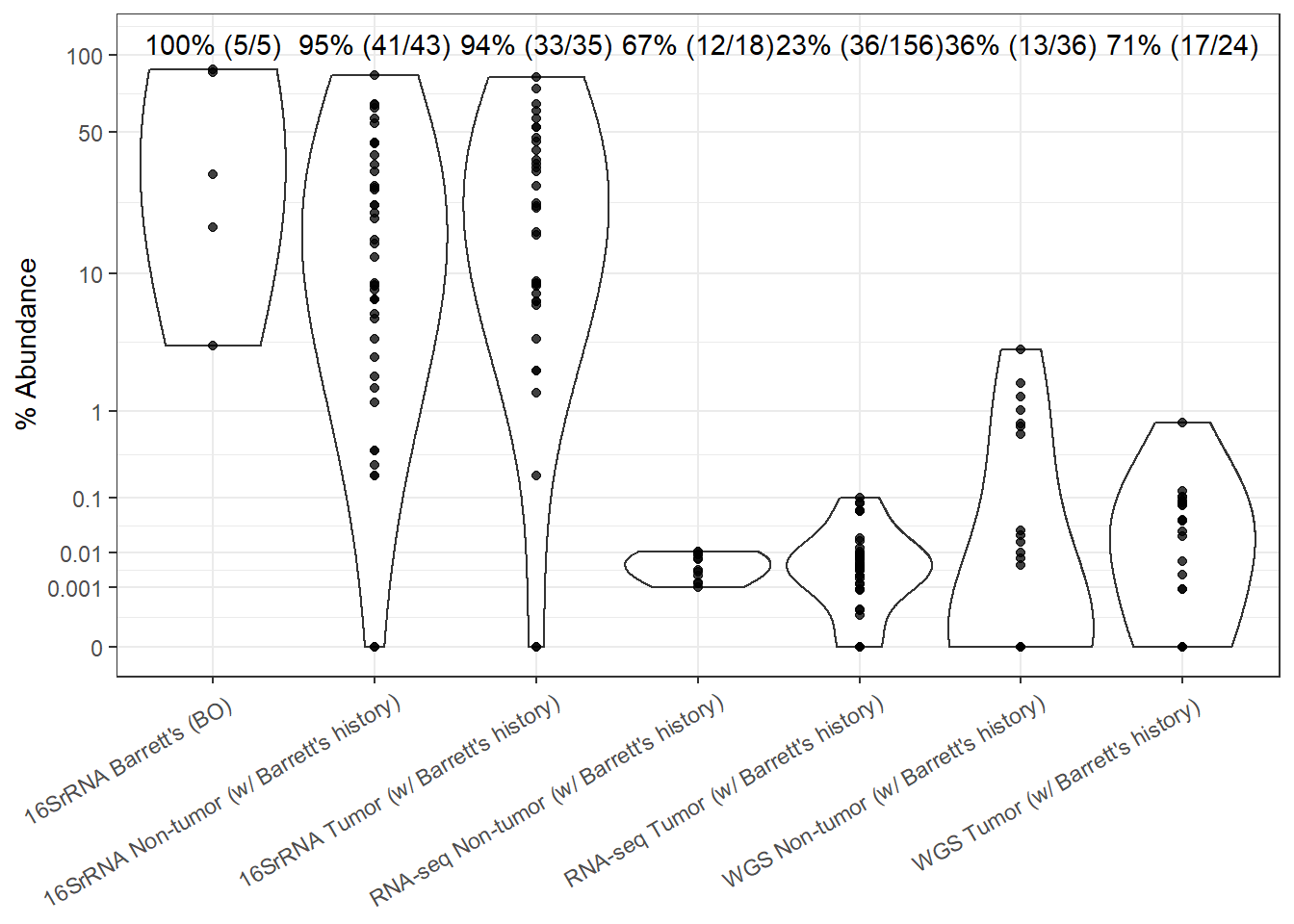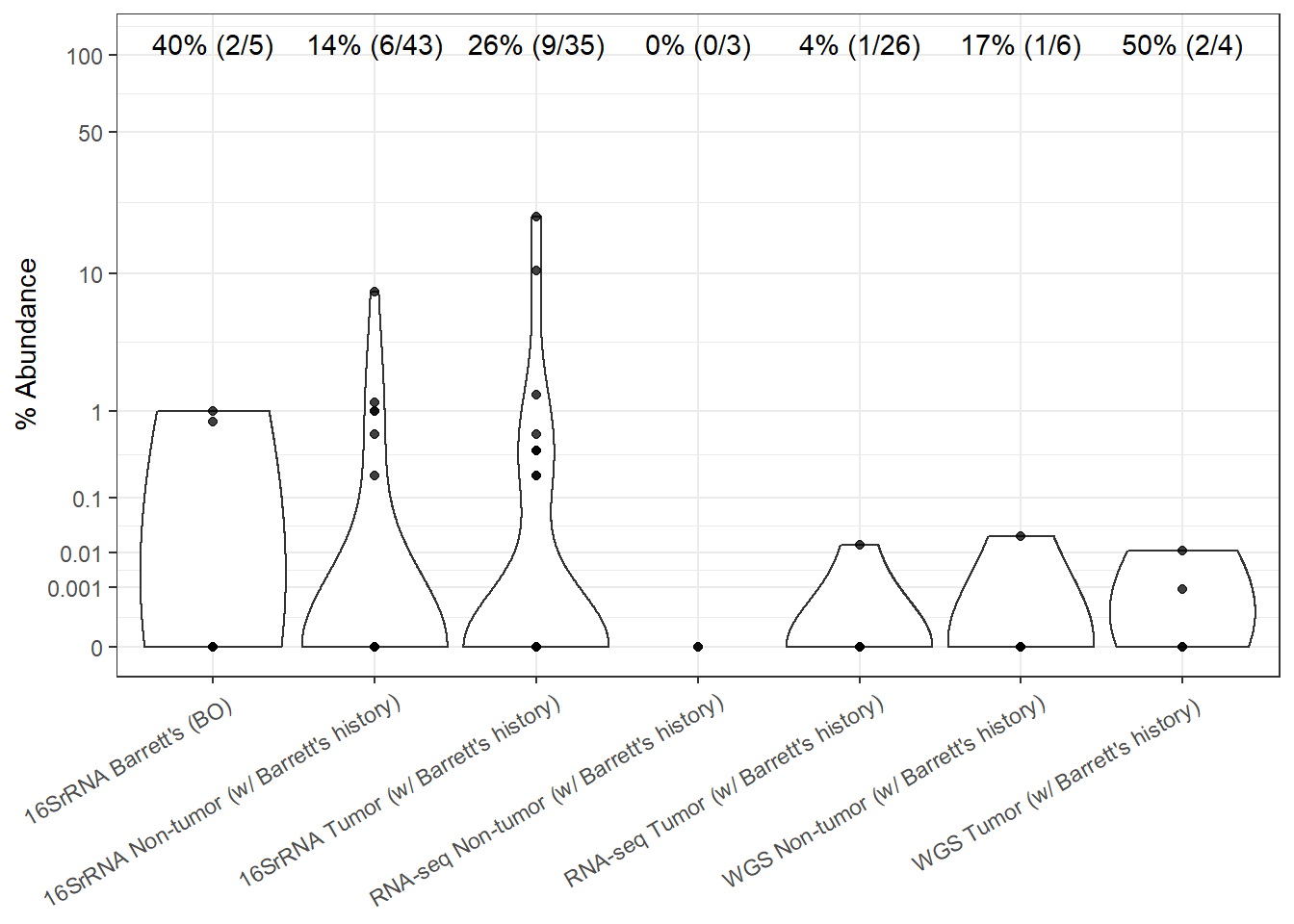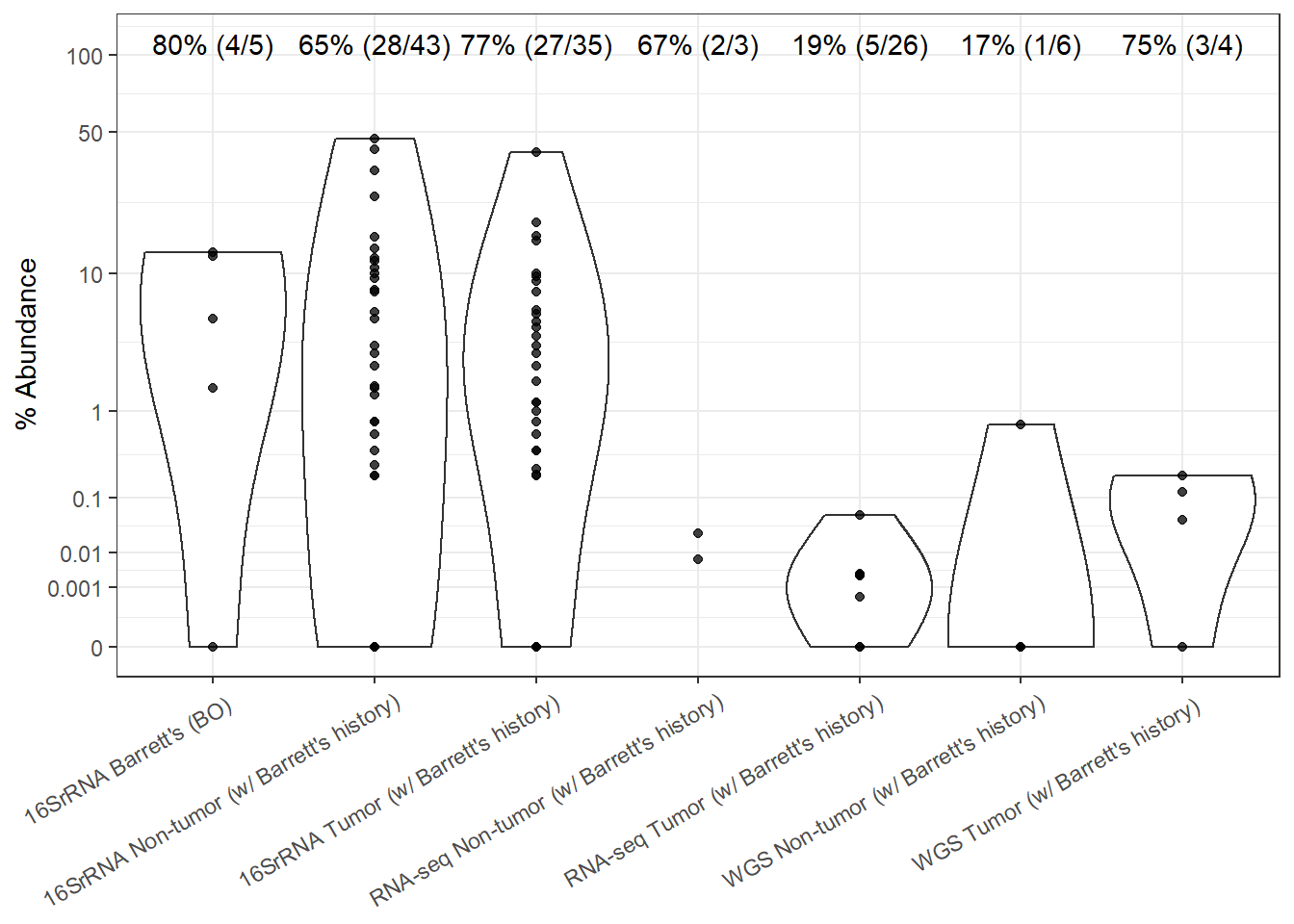Species Barretts Relationships
Last updated: 2021-02-25
Checks: 6 1
Knit directory: esoph-micro-cancer-workflow/
This reproducible R Markdown analysis was created with workflowr (version 1.6.2). The Checks tab describes the reproducibility checks that were applied when the results were created. The Past versions tab lists the development history.
The R Markdown file has unstaged changes. To know which version of the R Markdown file created these results, you’ll want to first commit it to the Git repo. If you’re still working on the analysis, you can ignore this warning. When you’re finished, you can run wflow_publish to commit the R Markdown file and build the HTML.
Great job! The global environment was empty. Objects defined in the global environment can affect the analysis in your R Markdown file in unknown ways. For reproduciblity it’s best to always run the code in an empty environment.
The command set.seed(20200916) was run prior to running the code in the R Markdown file. Setting a seed ensures that any results that rely on randomness, e.g. subsampling or permutations, are reproducible.
Great job! Recording the operating system, R version, and package versions is critical for reproducibility.
Nice! There were no cached chunks for this analysis, so you can be confident that you successfully produced the results during this run.
Great job! Using relative paths to the files within your workflowr project makes it easier to run your code on other machines.
Great! You are using Git for version control. Tracking code development and connecting the code version to the results is critical for reproducibility.
The results in this page were generated with repository version f91e666. See the Past versions tab to see a history of the changes made to the R Markdown and HTML files.
Note that you need to be careful to ensure that all relevant files for the analysis have been committed to Git prior to generating the results (you can use wflow_publish or wflow_git_commit). workflowr only checks the R Markdown file, but you know if there are other scripts or data files that it depends on. Below is the status of the Git repository when the results were generated:
Ignored files:
Ignored: .Rhistory
Ignored: .Rproj.user/
Ignored: data/
Unstaged changes:
Modified: analysis/species-sample-type-combined.Rmd
Note that any generated files, e.g. HTML, png, CSS, etc., are not included in this status report because it is ok for generated content to have uncommitted changes.
These are the previous versions of the repository in which changes were made to the R Markdown (analysis/species-sample-type-combined.Rmd) and HTML (docs/species-sample-type-combined.html) files. If you’ve configured a remote Git repository (see ?wflow_git_remote), click on the hyperlinks in the table below to view the files as they were in that past version.
| File | Version | Author | Date | Message |
|---|---|---|---|---|
| Rmd | f91e666 | noah-padgett | 2021-02-25 | violin updates |
| html | f91e666 | noah-padgett | 2021-02-25 | violin updates |
| Rmd | 13f1528 | alisonjung | 2021-02-18 | Barretts violin plot updates |
| Rmd | fe971b9 | noah-padgett | 2021-02-13 | violin plot scale fixed |
| Rmd | 285a2fb | noah-padgett | 2021-02-10 | updated violion plots |
| html | 285a2fb | noah-padgett | 2021-02-10 | updated violion plots |
#Violin Plot Fuso
# merge datasets by subsetting to specific variables then merging
analysis.dat <- dat.16s.s %>%
dplyr::mutate(ID = as.factor(accession.number)) %>%
dplyr::select(OTU, sample_type, Abundance, ID, source)
dat <- dat.rna.s %>%
dplyr::select(OTU, sample_type, Abundance, ID, source)
analysis.dat <- full_join(analysis.dat, dat)
dat <- dat.wgs.s %>%
dplyr::select(OTU, sample_type, Abundance, ID, source)
analysis.dat <- full_join(analysis.dat, dat) %>%
mutate(pres = ifelse(Abundance > 0, 1, 0)) %>%
filter(OTU=="Fusobacterium nucleatum")# create a presence/absences variable
tb <- analysis.dat %>%
filter(is.na(sample_type)==F)%>%
group_by(sample_type, OTU) %>%
summarise(
N=n(),
p = sum(pres, na.rm=T),
percent = p/N*100
)
kable(tb, format="html")%>%
kable_styling(full_width = T)| sample_type | OTU | N | p | percent |
|---|---|---|---|---|
| 16SrRNA Barrett’s (BO) | Fusobacterium nucleatum | 5 | 3 | 60.00000 |
| 16SrRNA Non-tumor (w/ Barrett’s history) | Fusobacterium nucleatum | 43 | 19 | 44.18605 |
| 16SrRNA Tumor (w/ Barrett’s history) | Fusobacterium nucleatum | 35 | 16 | 45.71429 |
| RNA-seq Non-tumor (w/ Barrett’s history) | Fusobacterium nucleatum | 3 | 2 | 66.66667 |
| RNA-seq Tumor (w/ Barrett’s history) | Fusobacterium nucleatum | 26 | 5 | 19.23077 |
| WGS Non-tumor (w/ Barrett’s history) | Fusobacterium nucleatum | 6 | 2 | 33.33333 |
| WGS Tumor (w/ Barrett’s history) | Fusobacterium nucleatum | 4 | 2 | 50.00000 |
analysis.dat <- analysis.dat %>%
filter(is.na(sample_type)==F)%>%
mutate(
Abund = Abundance*100
)
#root function
root<-function(x){
x <- ifelse(x < 0, 0, x)
x**(0.2)
}
#inverse root function
invroot<-function(x){
x**(5)
}
p <- ggplot(analysis.dat, aes(sample_type, Abund)) +
geom_violin(scale="width", adjust=2)+
geom_point(alpha=0.75)+
scale_y_continuous(
trans=scales::trans_new("root", root, invroot),
breaks=c(0, 0.001,0.01, 0.1, 1,10,50, 100),
labels = c(0, 0.001,0.01, 0.1, 1,10,50, 100),
limits = c(0, 110)
)+
annotate(
"text", x=c(1:7), y=c(rep(110, 7)),
label=c(paste0(round(tb[1,5], 0),"% (",tb[1,4],"/",tb[1,3],")"),
paste0(round(tb[2,5], 0),"% (",tb[2,4],"/",tb[2,3],")"),
paste0(round(tb[3,5], 0),"% (",tb[3,4],"/",tb[3,3],")"),
paste0(round(tb[4,5], 0),"% (",tb[4,4],"/",tb[4,3],")"),
paste0(round(tb[5,5], 0),"% (",tb[5,4],"/",tb[5,3],")"),
paste0(round(tb[6,5], 0),"% (",tb[6,4],"/",tb[6,3],")"),
paste0(round(tb[7,5], 0),"% (",tb[7,4],"/",tb[7,3],")"))
)+
labs(x=NULL, y="% Abundance")+
theme(
axis.text.x = element_text(angle=30, hjust=0.95, vjust=0.95)
)
p
ggsave("output/Barretts_violin-fuso.pdf", p, units = "in", width = 10, height = 6)#Violin Plot Strepto
# merge datasets by subsetting to specific variables then merging
analysis.dat <- dat.16s.s %>%
dplyr::mutate(ID = as.factor(accession.number)) %>%
dplyr::select(OTU, sample_type, Abundance, ID, source)
dat <- dat.rna.s %>%
dplyr::select(OTU, sample_type, Abundance, ID, source)
analysis.dat <- full_join(analysis.dat, dat)
dat <- dat.wgs.s %>%
dplyr::select(OTU, sample_type, Abundance, ID, source)
analysis.dat <- full_join(analysis.dat, dat) %>%
mutate(pres = ifelse(Abundance > 0, 1, 0)) %>%
filter(OTU=="Streptococcus spp.")# create a presence/absences variable
tb <- analysis.dat %>%
filter(is.na(sample_type)==F)%>%
group_by(sample_type, OTU) %>%
summarise(
N=n(),
p = sum(pres, na.rm=T),
percent = p/N*100
)
kable(tb, format="html")%>%
kable_styling(full_width = T)| sample_type | OTU | N | p | percent |
|---|---|---|---|---|
| 16SrRNA Barrett’s (BO) | Streptococcus spp. | 5 | 5 | 100.00000 |
| 16SrRNA Non-tumor (w/ Barrett’s history) | Streptococcus spp. | 43 | 41 | 95.34884 |
| 16SrRNA Tumor (w/ Barrett’s history) | Streptococcus spp. | 35 | 33 | 94.28571 |
| RNA-seq Non-tumor (w/ Barrett’s history) | Streptococcus spp. | 18 | 12 | 66.66667 |
| RNA-seq Tumor (w/ Barrett’s history) | Streptococcus spp. | 156 | 36 | 23.07692 |
| WGS Non-tumor (w/ Barrett’s history) | Streptococcus spp. | 36 | 13 | 36.11111 |
| WGS Tumor (w/ Barrett’s history) | Streptococcus spp. | 24 | 17 | 70.83333 |
analysis.dat <- analysis.dat %>%
filter(is.na(sample_type)==F)%>%
mutate(
Abund = Abundance*100
)
#root function
root<-function(x){
x <- ifelse(x < 0, 0, x)
x**(0.2)
}
#inverse root function
invroot<-function(x){
x**(5)
}
p <- ggplot(analysis.dat, aes(sample_type, Abund)) +
geom_violin(scale="width", adjust=2)+
geom_point(alpha=0.75)+
scale_y_continuous(
trans=scales::trans_new("root", root, invroot),
breaks=c(0, 0.001,0.01, 0.1, 1,10,50, 100),
labels = c(0, 0.001,0.01, 0.1, 1,10,50, 100),
limits = c(0, 110)
)+
annotate(
"text", x=c(1:7), y=c(rep(110, 7)),
label=c(paste0(round(tb[1,5], 0),"% (",tb[1,4],"/",tb[1,3],")"),
paste0(round(tb[2,5], 0),"% (",tb[2,4],"/",tb[2,3],")"),
paste0(round(tb[3,5], 0),"% (",tb[3,4],"/",tb[3,3],")"),
paste0(round(tb[4,5], 0),"% (",tb[4,4],"/",tb[4,3],")"),
paste0(round(tb[5,5], 0),"% (",tb[5,4],"/",tb[5,3],")"),
paste0(round(tb[6,5], 0),"% (",tb[6,4],"/",tb[6,3],")"),
paste0(round(tb[7,5], 0),"% (",tb[7,4],"/",tb[7,3],")"))
)+
labs(x=NULL, y="% Abundance")+
theme(
axis.text.x = element_text(angle=30, hjust=0.95, vjust=0.95)
)
p
ggsave("output/Barretts_violin-strepto.pdf", p, units = "in", width = 10, height = 6)#Violin Plot Campy
# merge datasets by subsetting to specific variables then merging
analysis.dat <- dat.16s.s %>%
dplyr::mutate(ID = as.factor(accession.number)) %>%
dplyr::select(OTU, sample_type, Abundance, ID, source)
dat <- dat.rna.s %>%
dplyr::select(OTU, sample_type, Abundance, ID, source)
analysis.dat <- full_join(analysis.dat, dat)
dat <- dat.wgs.s %>%
dplyr::select(OTU, sample_type, Abundance, ID, source)
analysis.dat <- full_join(analysis.dat, dat) %>%
mutate(pres = ifelse(Abundance > 0, 1, 0)) %>%
filter(OTU=="Campylobacter concisus")# create a presence/absences variable
tb <- analysis.dat %>%
filter(is.na(sample_type)==F)%>%
group_by(sample_type, OTU) %>%
summarise(
N=n(),
p = sum(pres, na.rm=T),
percent = p/N*100
)
kable(tb, format="html")%>%
kable_styling(full_width = T)| sample_type | OTU | N | p | percent |
|---|---|---|---|---|
| 16SrRNA Barrett’s (BO) | Campylobacter concisus | 5 | 2 | 40.000000 |
| 16SrRNA Non-tumor (w/ Barrett’s history) | Campylobacter concisus | 43 | 6 | 13.953488 |
| 16SrRNA Tumor (w/ Barrett’s history) | Campylobacter concisus | 35 | 9 | 25.714286 |
| RNA-seq Non-tumor (w/ Barrett’s history) | Campylobacter concisus | 3 | 0 | 0.000000 |
| RNA-seq Tumor (w/ Barrett’s history) | Campylobacter concisus | 26 | 1 | 3.846154 |
| WGS Non-tumor (w/ Barrett’s history) | Campylobacter concisus | 6 | 1 | 16.666667 |
| WGS Tumor (w/ Barrett’s history) | Campylobacter concisus | 4 | 2 | 50.000000 |
analysis.dat <- analysis.dat %>%
filter(is.na(sample_type)==F)%>%
mutate(
Abund = Abundance*100
)
#root function
root<-function(x){
x <- ifelse(x < 0, 0, x)
x**(0.2)
}
#inverse root function
invroot<-function(x){
x**(5)
}
p <- ggplot(analysis.dat, aes(sample_type, Abund)) +
geom_violin(scale="width", adjust=2)+
geom_point(alpha=0.75)+
scale_y_continuous(
trans=scales::trans_new("root", root, invroot),
breaks=c(0, 0.001,0.01, 0.1, 1,10,50, 100),
labels = c(0, 0.001,0.01, 0.1, 1,10,50, 100),
limits = c(0, 110)
)+
annotate(
"text", x=c(1:7), y=c(rep(110, 7)),
label=c(paste0(round(tb[1,5], 0),"% (",tb[1,4],"/",tb[1,3],")"),
paste0(round(tb[2,5], 0),"% (",tb[2,4],"/",tb[2,3],")"),
paste0(round(tb[3,5], 0),"% (",tb[3,4],"/",tb[3,3],")"),
paste0(round(tb[4,5], 0),"% (",tb[4,4],"/",tb[4,3],")"),
paste0(round(tb[5,5], 0),"% (",tb[5,4],"/",tb[5,3],")"),
paste0(round(tb[6,5], 0),"% (",tb[6,4],"/",tb[6,3],")"),
paste0(round(tb[7,5], 0),"% (",tb[7,4],"/",tb[7,3],")"))
)+
labs(x=NULL, y="% Abundance")+
theme(
axis.text.x = element_text(angle=30, hjust=0.95, vjust=0.95)
)
p
ggsave("output/Barretts_violin-campy.pdf", p, units = "in", width = 10, height = 6)#Violin Plot Prevo
# merge datasets by subsetting to specific variables then merging
analysis.dat <- dat.16s.s %>%
dplyr::mutate(ID = as.factor(accession.number)) %>%
dplyr::select(OTU, sample_type, Abundance, ID, source)
dat <- dat.rna.s %>%
dplyr::select(OTU, sample_type, Abundance, ID, source)
analysis.dat <- full_join(analysis.dat, dat)
dat <- dat.wgs.s %>%
dplyr::select(OTU, sample_type, Abundance, ID, source)
analysis.dat <- full_join(analysis.dat, dat) %>%
mutate(pres = ifelse(Abundance > 0, 1, 0)) %>%
filter(OTU=="Prevotella melaninogenica")# create a presence/absences variable
tb <- analysis.dat %>%
filter(is.na(sample_type)==F)%>%
group_by(sample_type, OTU) %>%
summarise(
N=n(),
p = sum(pres, na.rm=T),
percent = p/N*100
)
kable(tb, format="html")%>%
kable_styling(full_width = T)| sample_type | OTU | N | p | percent |
|---|---|---|---|---|
| 16SrRNA Barrett’s (BO) | Prevotella melaninogenica | 5 | 4 | 80.00000 |
| 16SrRNA Non-tumor (w/ Barrett’s history) | Prevotella melaninogenica | 43 | 28 | 65.11628 |
| 16SrRNA Tumor (w/ Barrett’s history) | Prevotella melaninogenica | 35 | 27 | 77.14286 |
| RNA-seq Non-tumor (w/ Barrett’s history) | Prevotella melaninogenica | 3 | 2 | 66.66667 |
| RNA-seq Tumor (w/ Barrett’s history) | Prevotella melaninogenica | 26 | 5 | 19.23077 |
| WGS Non-tumor (w/ Barrett’s history) | Prevotella melaninogenica | 6 | 1 | 16.66667 |
| WGS Tumor (w/ Barrett’s history) | Prevotella melaninogenica | 4 | 3 | 75.00000 |
analysis.dat <- analysis.dat %>%
filter(is.na(sample_type)==F)%>%
mutate(
Abund = Abundance*100
)
#root function
root<-function(x){
x <- ifelse(x < 0, 0, x)
x**(0.2)
}
#inverse root function
invroot<-function(x){
x**(5)
}
p <- ggplot(analysis.dat, aes(sample_type, Abund)) +
geom_violin(scale="width", adjust=2)+
geom_point(alpha=0.75)+
scale_y_continuous(
trans=scales::trans_new("root", root, invroot),
breaks=c(0, 0.001,0.01, 0.1, 1,10,50, 100),
labels = c(0, 0.001,0.01, 0.1, 1,10,50, 100),
limits = c(0, 110)
)+
annotate(
"text", x=c(1:7), y=c(rep(110, 7)),
label=c(paste0(round(tb[1,5], 0),"% (",tb[1,4],"/",tb[1,3],")"),
paste0(round(tb[2,5], 0),"% (",tb[2,4],"/",tb[2,3],")"),
paste0(round(tb[3,5], 0),"% (",tb[3,4],"/",tb[3,3],")"),
paste0(round(tb[4,5], 0),"% (",tb[4,4],"/",tb[4,3],")"),
paste0(round(tb[5,5], 0),"% (",tb[5,4],"/",tb[5,3],")"),
paste0(round(tb[6,5], 0),"% (",tb[6,4],"/",tb[6,3],")"),
paste0(round(tb[7,5], 0),"% (",tb[7,4],"/",tb[7,3],")"))
)+
labs(x=NULL, y="% Abundance")+
theme(
axis.text.x = element_text(angle=30, hjust=0.95, vjust=0.95)
)
p
ggsave("output/Barretts_violin-prevo.pdf", p, units = "in", width = 10, height = 6)
sessionInfo()R version 4.0.3 (2020-10-10)
Platform: x86_64-w64-mingw32/x64 (64-bit)
Running under: Windows 10 x64 (build 19042)
Matrix products: default
locale:
[1] LC_COLLATE=English_United States.1252
[2] LC_CTYPE=English_United States.1252
[3] LC_MONETARY=English_United States.1252
[4] LC_NUMERIC=C
[5] LC_TIME=English_United States.1252
attached base packages:
[1] stats graphics grDevices utils datasets methods base
other attached packages:
[1] cowplot_1.1.1 dendextend_1.14.0 ggdendro_0.1.22 reshape2_1.4.4
[5] car_3.0-10 carData_3.0-4 gvlma_1.0.0.3 patchwork_1.1.1
[9] viridis_0.5.1 viridisLite_0.3.0 gridExtra_2.3 xtable_1.8-4
[13] kableExtra_1.3.1 MASS_7.3-53 data.table_1.13.6 readxl_1.3.1
[17] forcats_0.5.1 stringr_1.4.0 dplyr_1.0.3 purrr_0.3.4
[21] readr_1.4.0 tidyr_1.1.2 tibble_3.0.6 ggplot2_3.3.3
[25] tidyverse_1.3.0 lmerTest_3.1-3 lme4_1.1-26 Matrix_1.2-18
[29] vegan_2.5-7 lattice_0.20-41 permute_0.9-5 phyloseq_1.34.0
[33] workflowr_1.6.2
loaded via a namespace (and not attached):
[1] minqa_1.2.4 colorspace_2.0-0 rio_0.5.16
[4] ellipsis_0.3.1 rprojroot_2.0.2 XVector_0.30.0
[7] fs_1.5.0 rstudioapi_0.13 farver_2.0.3
[10] lubridate_1.7.9.2 xml2_1.3.2 codetools_0.2-16
[13] splines_4.0.3 knitr_1.31 ade4_1.7-16
[16] jsonlite_1.7.2 nloptr_1.2.2.2 broom_0.7.4
[19] cluster_2.1.0 dbplyr_2.1.0 BiocManager_1.30.10
[22] compiler_4.0.3 httr_1.4.2 backports_1.2.1
[25] assertthat_0.2.1 cli_2.3.0 later_1.1.0.1
[28] htmltools_0.5.1.1 prettyunits_1.1.1 tools_4.0.3
[31] igraph_1.2.6 gtable_0.3.0 glue_1.4.2
[34] Rcpp_1.0.6 Biobase_2.50.0 cellranger_1.1.0
[37] vctrs_0.3.6 Biostrings_2.58.0 rhdf5filters_1.2.0
[40] multtest_2.46.0 ape_5.4-1 nlme_3.1-149
[43] iterators_1.0.13 xfun_0.20 ps_1.5.0
[46] openxlsx_4.2.3 rvest_0.3.6 lifecycle_0.2.0
[49] statmod_1.4.35 zlibbioc_1.36.0 scales_1.1.1
[52] hms_1.0.0 promises_1.1.1 parallel_4.0.3
[55] biomformat_1.18.0 rhdf5_2.34.0 curl_4.3
[58] yaml_2.2.1 stringi_1.5.3 highr_0.8
[61] S4Vectors_0.28.1 foreach_1.5.1 BiocGenerics_0.36.0
[64] zip_2.1.1 boot_1.3-25 rlang_0.4.10
[67] pkgconfig_2.0.3 evaluate_0.14 Rhdf5lib_1.12.1
[70] tidyselect_1.1.0 plyr_1.8.6 magrittr_2.0.1
[73] R6_2.5.0 IRanges_2.24.1 generics_0.1.0
[76] DBI_1.1.1 foreign_0.8-80 pillar_1.4.7
[79] haven_2.3.1 whisker_0.4 withr_2.4.1
[82] mgcv_1.8-33 abind_1.4-5 survival_3.2-7
[85] modelr_0.1.8 crayon_1.4.1 rmarkdown_2.6
[88] progress_1.2.2 grid_4.0.3 git2r_0.28.0
[91] reprex_1.0.0 digest_0.6.27 webshot_0.5.2
[94] httpuv_1.5.5 numDeriv_2016.8-1.1 stats4_4.0.3
[97] munsell_0.5.0